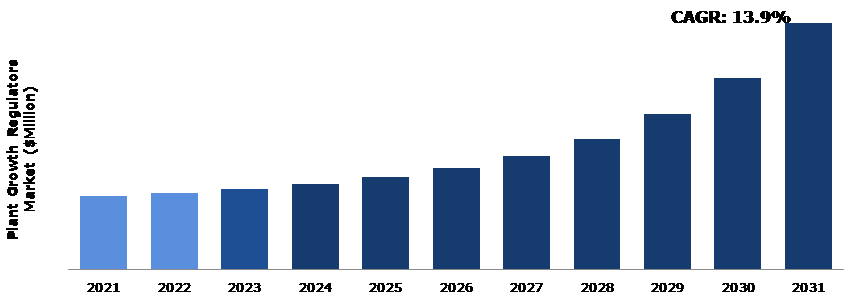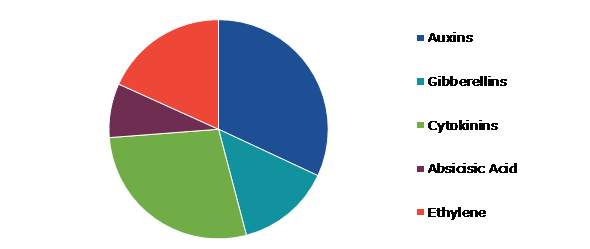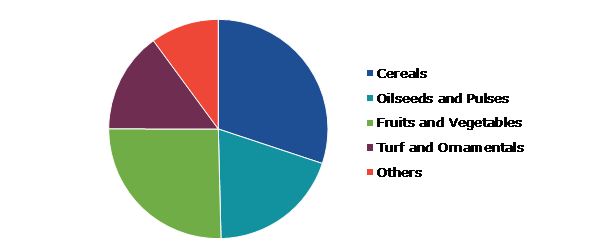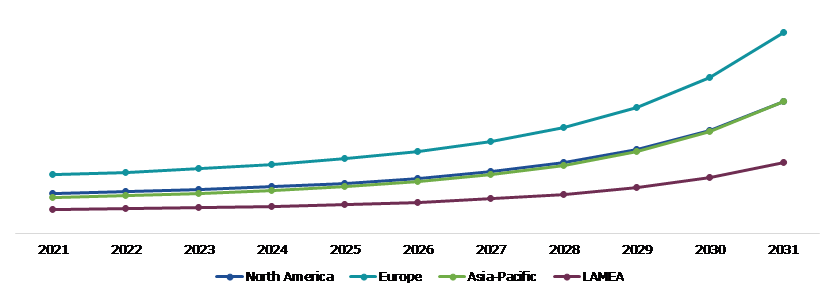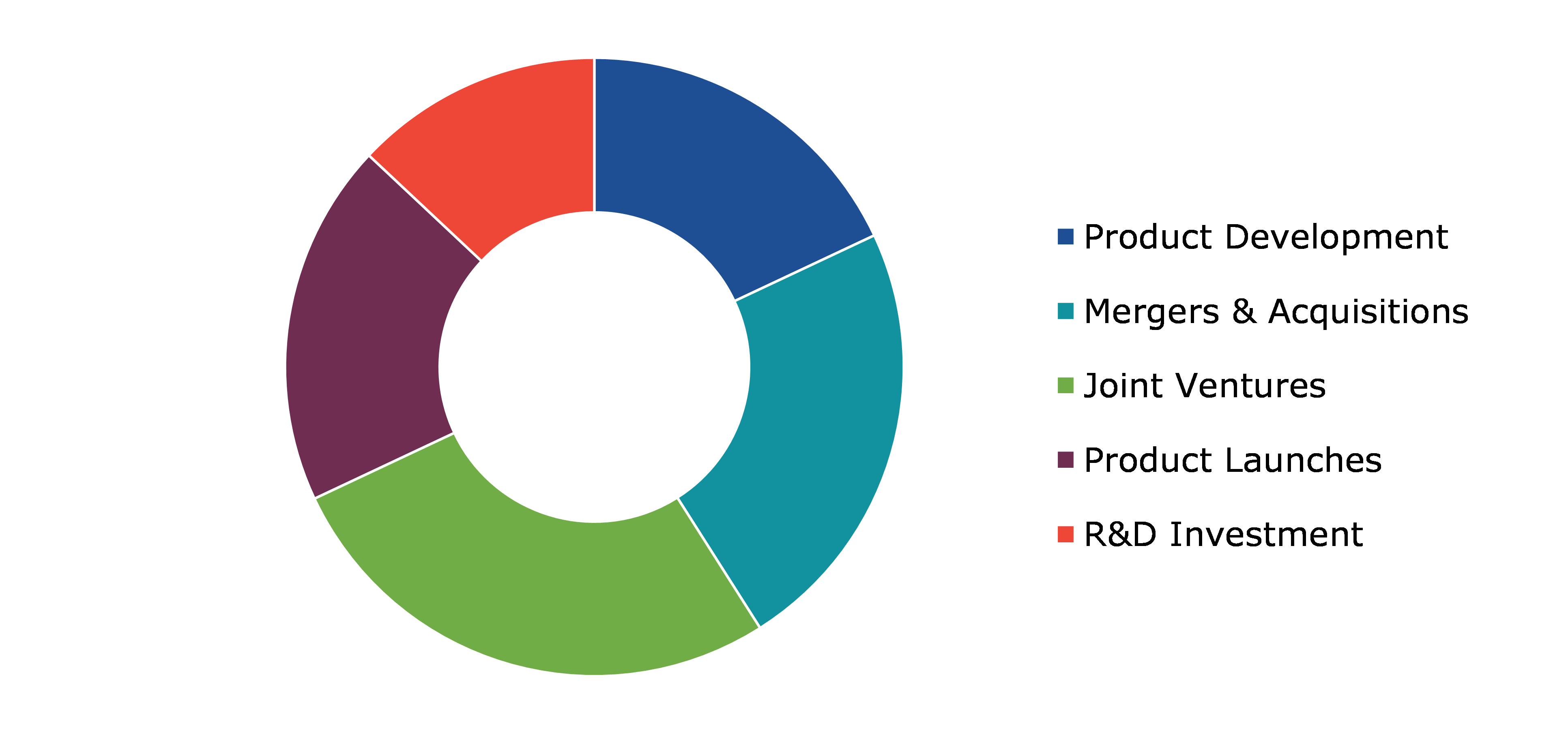Plant Growth Regulators Market Report
RA06282
Plant Growth Regulators Market by Type (Auxins, Gibberellins, Cytokinins, Absicisic Acid, and Ethylene), Crop Type (Cereals, Oilseeds and Pulses, Fruits and Vegetables, Turf and Ornamentals, and Others), and Regional Analysis (North America, Europe, Asia-Pacific, and LAMEA): Global Opportunity Analysis and Industry Forecast, 2022-2031
Global Plant Growth Regulators Market Analysis
The Global Plant Growth Regulators Market Size was $2,196.30 million in 2021 and is predicted to grow with a CAGR of 13.9%, by generating a revenue of $7,393.50 million by 2031.
Global Plant Growth Regulators Market Synopsis
Plant growth regulators (PGRs) are chemicals that are used to manipulate plant growth by increasing branching, suppressing shoot growth, increasing return bloom, removing excess fruit, or changing fruit maturity. The plant-growth regulators market is being driven by a number of factors. This market is being driven by rising food demand, shrinking arable land area, and changing climatic conditions. The market is also being propelled forward by the need for higher crop yields and higher-quality crops. Another key driver of market growth is the wide range of applications for plant-growth regulators. These chemicals can be used to control plant growth in a variety of ways, such as germination, dormancy, flowering, fruit set, and ripening. Because of their versatility, they are useful tools for both farmers and horticulturists. These factors are anticipated to boost the plant growth regulators industry growth in the upcoming years.
Reduced profit margins will not help plant growth regulators gain market share in the global agrochemicals market. Even for generic products, the registration process can take up to five years. The regulatory bodies lack the necessary resources and infrastructure to complete product registrations on time. At times, the rules are not clearly defined, posing interpretation challenges for regulatory bodies and leading to confusion, further complicating matters for crop protection chemical companies.
Plant growth regulators are in high demand because of their ability to reduce lodging in intensive cereal production, control shoot heights, and stimulate latex flow in rubber plants. These factors stimulate plant growth and accelerate production when compared to traditional fertilizers, which is expected to have a positive impact on market growth in the coming years. The market's value chain structure is heavily influenced by economic and environmental factors, product nature, upstream raw material supplies, and downstream structure. The final products are distributed globally through online and physical retailing.
According to regional analysis, the Europe plant growth regulators market accounted for highest market share in 2021 and is predicted to grow with a highest CAGR in projected timeframe. Europe has high exports of fruits and vegetables both within the region and to other regions.
Plant Growth Regulators Market Overview
Plant growth regulators are enzymes that promote the growth and isolation of plant cells, tissues, and organs. They function as chemical messengers, facilitating intercellular communication. These growth regulators are naturally produced within the plant body, but in small amounts. Manipulation causes cell division, cell expansion, leaf senescence, fruit and vegetable ripening, fruit and flower maturation, and seed germination. Plant hormones are classified into five groups: auxins, gibberellins, cytokinins, abscisic acid (ABA), and ethylene. Their collaborative efforts aid in the growth and development of plant cells.
COVID-19 Impact on Global Plant Growth Regulators Market
The COVID-19 pandemic has brought several uncertainties leading to severe economic losses as various businesses across the world were standstill. This has ultimately lowered the demand for plant growth regulators due to disruptions in supply chain, closure of manufacturing plants, as well as economic slowdown across several countries. In addition, the COVID-19 pandemic has had a significant global impact on agricultural activities and associated industries. The impact varies greatly across geographies, depending on the spread of the virus and subsequent restrictions imposed. Plant growth regulators, as a class of agrochemicals or agricultural inputs, have been relatively unaffected by the pandemic. Agrochemical activities such as production, distribution, and sales are exempted as essential industries. To meet the COVID-19 protocols, companies should work with lower operating capacities and employees. To some extent, this has resulted in a decrease in the production of plant growth regulators.
Various initiatives taken by the Indian government to support plant growth regulators projects are helping the society to recover from the pandemic. For instance, in September 2020, the Indian government introduced three Agri-reform bills, all aimed at increasing farmers' incomes in the coming years: the Farmers' Produce Trade and Commerce (Promotion and Facilitation), the Farmers' (Empowerment and Protection) Price Assurance and Farm Services Agreement, and the Essential Commodities (Amendment) Act.
Increasing Demand for Sustainable Agricultural Practices to Drive the Market Growth
Plant growth regulators can help increase blossom rate, stimulate plant growth, and delay the onset of root crop sprouting. Such positive results alter plant nutrition and aid commercial agribusinesses in increasing crop yield quality and quantity. Plant growth regulators (PGR) are known to promote growth and development in both optimal and stress conditions. Reducing crop loss as a result of these climatic variations is a major challenge that will necessitate significant changes in crop improvement programs and agronomical practices. Plant growth regulators (PGRs) are useful tools in combating these stresses and climate variation for sustainable crop production under these conditions. Furthermore, organic products are becoming more popular. Growing health consciousness and income levels are driving up demand for organic fruits and vegetables. The increased demand for organic fruits and vegetables is expected to drive the plant growth regulators market share growth.
To know more about global plant growth regulators market drivers, get in touch with our analysts here.
Lack of Awareness among Farmers Regarding Plant Growth Regulators is Restricting the Market Growth
Plant growth regulators are chemicals that regulate the growth of plant cells, tissues, and organs. Plant growth regulators can help increase agricultural yield. The vast majority of Indian farmers are uninformed about the various types of plant growth regulators on the market. Furthermore, farmers are unaware of the financial advantages of using growth regulators. Farmers have traditionally used pesticides and fertilizers in crop production techniques. Moreover, the majority of agriculture takes place in rural areas, where farmers are often unaware of new technologies and products. As a result, the plant growth regulators market size expansion is hampered by farmers' lack of knowledge about plant growth regulators.
Initiatives To Increase Agriculture's Sustainability Offer a Profitable Market For Plant Growth Regulators
Growing initiatives aimed at making farming more sustainable present a lucrative opportunity for plant growth regulators market growth, worldwide. According to one estimate from the United States Department of Agriculture (USDA), the government invested more than USD 146 million in sustainable agricultural research projects in October 2021, which will improve crop resilience and help produce climate-smart foods. Plant growth regulators are proving to be a critical component in the advancement of sustainable agriculture initiatives. As a result, the increased emphasis on such initiatives is expected to drive demand for plant growth regulators, thereby propelling the global plant growth regulators market forward. According to one National Investment Promotion and Facilitation Agency estimate, demand for cereal products in India has increased significantly. Food exports increased by an astounding 415.36% from April-June 2020 to April-June 2021, indicating the country's rapid demand for cereal production. These are lucrative opportunities for the global market's growth.
To know more about global plant growth regulators market opportunities, get in touch with our analysts here.
Global Plant Growth Regulators Market, by Type
Based on type, the market has been divided into auxins, gibberellins, cytokinins, absicisic acid, and ethylene. Among these, the auxins sub-segment accounted for the highest market share in 2021 whereas the Cytokinins sub-segment is estimated to show the fastest growth during the forecast period.
Global Plant Growth Regulators Market Size, by Type, 2021
Source: Research Dive Analysis
The auxins sub-type accounted for a highest market share in 2021. Auxins are plant hormones that occur naturally and are synthesized artificially. They are crucial in the regulation of plant growth. Initially, auxins were isolated from human urine. Auxin means to "enlarge" or "increase". They stimulate cell division, differentiation, and lengthening. Auxins are expected to grow moderately in the coming years. It is used as a rooting hormone to control the growth of plant cells. The majority of auxins are used in tissue culture and plant propagation.
The Cytokinins sub-type is predicted to show the fastest growth in 2031. Cytokinins promote cell division. Cytokinins are involved in branching and stimulating bud initiation. They are used as fruit thinners in apples. Cytokinins help plants deal with stress and promote protein synthesis. They also have several advantages, such as delaying plant ageing and preventing leaf senescence. They are commonly used in mature plants to aid in their development. Furthermore, depending on the crop and soil type, cytokinins are used to repair the injured parts of plants.
Global Plant Growth Regulators Market, by Crop type
Based on crop type, the market has been divided into cereals, oilseeds and pulses, fruits and vegetables, turf and ornamentals, and others. Among these, the Cereals sub-segment accounted for highest revenue share in 2021.
Global Plant Growth Regulators Market Share, by Crop Type, 2021
Source: Research Dive Analysis
The Cereals sub-segment accounted for a highest market share in 2021. Cereal, also known as grain, is any grass that produces edible starchy seeds. Most grains have similar dietary properties; they are high in carbohydrates but low in protein, and they are naturally low in calcium and vitamin A. Additionally, increasing population and changing consumer lifestyles are driving up global demand for all types of crops, particularly cereals. Rising cereal production in Asian countries such as India and China is due to significant improvements in crop production practices and the increased availability of high-productivity cereal varieties.
Global Plant Growth Regulators Market, Regional Insights
The plant growth regulators market was investigated across North America, Europe, Asia-Pacific, and LAMEA.
Global Plant Growth Regulators Market Size & Forecast, by Region, 2021-2031 (USD Million)
Source: Research Dive Analysis
The Market for Plant Growth Regulators Market in Europe to be the Most Dominant
The plant growth regulators market accounted for a highest market share in 2021. The increased demand is due to the growth of organic farming and the expansion of indoor farming units such as greenhouses and glasshouses. Plant growth regulators are increasingly being used by vegetables and fruits, driving the market. Sustainable agriculture, food security, and rural development are all promoted by European countries. The European Commission has committed to the Farm to Fork Strategy, which is centered on organic farming, in the European Union. By 2030, 25% of the EU's agricultural land will be used for organic farming under this strategy. As a result, increasing crop yield while maintaining sustainability has become increasingly important. As a result of the large-scale organic farming industry in Europe, where specific plant hormones such as cytokinin, auxins, and gibberellins are used in various farming methods, demand for plant growth regulators is significantly high. Companies are introducing new products into the market to meet this rising demand. For instance, on 21 January 2020, BASF launched Attraxor a new plant growth regulator (PGR) at BTME in Harrogate. The product is new to the UK market and features the powerful active Prohexadione calcium.
Competitive Scenario in the Global Plant Growth Regulators Market
Investment and agreement are common strategies followed by major market players. For instance, in April 2020, in the United Kingdom, BASF launched Attraxor, a plant growth regulator for turf and other types of grasses. Its primary ingredient is Prohexadion (10%w/w).
Source: Research Dive Analysis
Some of the leading plant growth regulators market players are BASF SE, Bayer Crop Science, Corteva Agriscience, Crop Care Australasia Pty Ltd., Barclay Crop Protection, Sumitomo Chemical Australia Pty Ltd., NuFarm Ltd., Redox Industries Ltd., Xinyi (H.K.) Industrial Co. Ltd., and Sichuan Guoguang Agrochemical Co. Ltd.
| Aspect | Particulars |
| Historical Market Estimations | 2020 |
| Base Year for Market Estimation | 2021 |
| Forecast Timeline for Market Projection | 2022-2031 |
| Geographical Scope | North America, Europe, Asia-Pacific, and LAMEA |
| Segmentation by Type |
|
| Segmentation by Crop Type |
|
| Key Companies Profiled |
|
Q1. What is the size of the global plant growth regulators market?
A. The size of the global plant growth regulators market was over $2,196.30 million in 2021 and is projected to reach $7,393.50 million by 2031.
Q2. Which are the major companies in the plant growth regulators market?
A. BASF SE, Bayer Crop Science, and Corteva Agriscience are some of the key players in the global plant growth regulators market.
Q3. Which region, among others, possesses greater investment opportunities in the near future?
A. The Asia-Pacific region possesses great investment opportunities for investors to witness the most promising growth in the future.
Q4. What will be the growth rate of the Asia-Pacific plant growth regulators market?
A. Asia-Pacific plant growth regulators market is anticipated to grow at 15.0% CAGR during the forecast period.
Q5. What are the strategies opted by the leading players in this market?
A. Agreement and investment are the two key strategies opted by the operating companies in this market.
Q6. Which companies are investing more on R&D practices?
A. BASF SE, Bayer Crop Science, and Corteva Agriscience are the companies investing more on R&D activities for developing new products and technologies.
1.Research Methodology
1.1.Desk Research
1.2.Real time insights and validation
1.3.Forecast model
1.4.Assumptions and forecast parameters
1.5.Market size estimation
1.5.1.Top-down approach
1.5.2.Bottom-up approach
2.Report Scope
2.1.Market definition
2.2.Key objectives of the study
2.3.Report overview
2.4.Market segmentation
3.Overview of the impact of COVID-19 on the global plant growth regulators market
4.Executive Summary
5.Market Overview
5.1.Introduction
5.2.Growth impact forces
5.2.1.Drivers
5.2.2.Restraints
5.2.3.Opportunities
5.3.Market value chain analysis
5.3.1.List of raw material suppliers
5.3.2.List of manufacturers
5.3.3.List of distributors
5.4.Innovation & sustainability matrices
5.4.1.Technology matrix
5.4.2.Regulatory matrix
5.5.Porter’s five forces analysis
5.5.1.Bargaining power of suppliers
5.5.2.Bargaining power of consumers
5.5.3.Threat of substitutes
5.5.4.Threat of new entrants
5.5.5.Competitive rivalry intensity
5.6.PESTLE analysis
5.6.1.Political
5.6.2.Economical
5.6.3.Social
5.6.4.Technological
5.6.5.Environmental
5.7.Impact of COVID-19 on the plant growth regulators market
5.7.1.Pre-covid market scenario
5.7.2.Post-covid market scenario
6.Plant Growth Regulators Market Analysis, by Type
6.1.Overview
6.2.Auxins
6.2.1.Definition, key trends, growth factors, and opportunities
6.2.2.Market size analysis, by region, 2021-2031
6.2.3.Market share analysis, by country, 2021-2031
6.3.Gibberellins
6.3.1.Definition, key trends, growth factors, and opportunities
6.3.2.Market size analysis, by region, 2021-2031
6.3.3.Market share analysis, by country, 2021-2031
6.4.Cytokinins
6.4.1.Definition, key trends, growth factors, and opportunities
6.4.2.Market size analysis, by region, 2021-2031
6.4.3.Market share analysis, by country, 2021-2031
6.5.Absicisic Acid
6.5.1.Definition, key trends, growth factors, and opportunities
6.5.2.Market size analysis, by region, 2021-2031
6.5.3.Market share analysis, by country, 2021-2031
6.6.Ethylene
6.6.1.Definition, key trends, growth factors, and opportunities
6.6.2.Market size analysis, by region, 2021-2031
6.6.3.Market share analysis, by country, 2021-2031
6.7.Research Dive Exclusive Insights
6.7.1.Market attractiveness
6.7.2.Competition heatmap
7.Plant Growth Regulators Market Analysis, by Crop Type
7.1.Cereals
7.1.1.Definition, key trends, growth factors, and opportunities
7.1.2.Market size analysis, by region, 2021-2031
7.1.3.Market share analysis, by country, 2021-2031
7.2.Oilseeds and Pulses
7.2.1.Definition, key trends, growth factors, and opportunities
7.2.2.Market size analysis, by region, 2021-2031
7.2.3.Market share analysis, by country, 2021-2031
7.3.Fruits and Vegetables
7.3.1.Definition, key trends, growth factors, and opportunities
7.3.2.Market size analysis, by region, 2021-2031
7.3.3.Market share analysis, by country, 2021-2031
7.4.Turf and Ornamentals
7.4.1.Definition, key trends, growth factors, and opportunities
7.4.2.Market size analysis, by region, 2021-2031
7.4.3.Market share analysis, by country,2021-2031
7.5.Others
7.5.1.Definition, key trends, growth factors, and opportunities
7.5.2.Market size analysis, by region, 2021-2031
7.5.3.Market share analysis, by country, 2021-3031
7.6.Research Dive Exclusive Insights
7.6.1.Market attractiveness
7.6.2.Competition heatmap
8.Plant Growth Regulators Market, by Region
8.1.North America
8.1.1.U.S.
8.1.1.1.Market size analysis, by Type, 2021-2031
8.1.1.2.Market size analysis, by Crop type, 2021-2031
8.1.2.Canada
8.1.2.1.Market size analysis, by Type, 2021-2031
8.1.2.2.Market size analysis, by Crop type, 2021-2031
8.1.3.Mexico
8.1.3.1.Market size analysis, by Type, 2021-2031
8.1.3.2.Market size analysis, by Crop type, 2021-2031
8.1.4.Research Dive Exclusive Insights
8.1.4.1.Market attractiveness
8.1.4.2.Competition heatmap
8.2.Europe
8.2.1.Germany
8.2.1.1.Market size analysis, by Type, 2021-2031
8.2.1.2.Market size analysis, by Crop type, 2021-2031
8.2.2.UK
8.2.2.1.Market size analysis, by Type, 2021-2031
8.2.2.2.Market size analysis, by Crop type, 2021-2031
8.2.3.France
8.2.3.1.Market size analysis, by Type, 2021-2031
8.2.3.2.Market size analysis, by Crop type, 2021-2031
8.2.4.Spain
8.2.4.1.Market size analysis, by Type, 2021-2031
8.2.4.2.Market size analysis, by Crop type, 2021-2031
8.2.5.Italy
8.2.5.1.Market size analysis, by Type, 2021-2031
8.2.5.2.Market size analysis, by Crop type, 2021-2031
8.2.6.Rest of Europe
8.2.6.1.Market size analysis, by Type, 2021-2031
8.2.6.2.Market size analysis, by Crop type, 2021-2031
8.2.7.Research Dive Exclusive Insights
8.2.7.1.Market attractiveness
8.2.7.2.Competition heatmap
8.3.Asia-Pacific
8.3.1.China
8.3.1.1.Market size analysis, by Type, 2021-2031
8.3.1.2.Market size analysis, by Crop type, 2021-2031
8.3.2.Japan
8.3.2.1.Market size analysis, by Type, 2021-2031
8.3.2.2.Market size analysis, by Crop type, 2021-2031
8.3.3.India
8.3.3.1.Market size analysis, by Type, 2021-2031
8.3.3.2.Market size analysis, by Crop type, 2021-2031
8.3.4.Australia
8.3.4.1.Market size analysis, by Type, 2021-2031
8.3.4.2.Market size analysis, by Crop type, 2021-2031
8.3.5.South Korea
8.3.5.1.Market size analysis, by Type, 2021-2031
8.3.5.2.Market size analysis, by Crop type, 2021-2031
8.3.6.Rest of Asia-Pacific
8.3.6.1.Market size analysis, by Type, 2021-2031
8.3.6.2.Market size analysis, by Crop type, 2021-2031
8.3.7.Research Dive Exclusive Insights
8.3.7.1.Market attractiveness
8.3.7.2.Competition heatmap
8.4.LAMEA
8.4.1.Brazil
8.4.1.1.Market size analysis, by Type, 2021-2031
8.4.1.2.Market size analysis, by Crop type, 2021-2031
8.4.2.Saudi Arabia
8.4.2.1.Market size analysis, by Type, 2021-2031
8.4.2.2.Market size analysis, by Crop type, 2021-2031
8.4.3.UAE
8.4.3.1.Market size analysis, by Type, 2021-2031
8.4.3.2.Market size analysis, by Crop type, 2021-2031
8.4.4.South Africa
8.4.4.1.Market size analysis, by Type, 2021-2031
8.4.4.2.Market size analysis, by Crop type, 2021-2031
8.4.5.Rest of LAMEA
8.4.5.1.Market size analysis, by Type, 2021-2031
8.4.5.2.Market size analysis, by Crop type, 2021-2031
8.4.6.Research Dive Exclusive Insights
8.4.6.1.Market attractiveness
8.4.6.2.Competition heatmap
9.Competitive Landscape
9.1.Top winning strategies, 2021
9.1.1.By strategy
9.1.2.By year
9.2.Strategic overview
9.3.Market share analysis, 2021
10.Company Profiles
10.1.BASF SE
10.1.1.Overview
10.1.2.Business segments
10.1.3.Product portfolio
10.1.4.Financial performance
10.1.5.Recent developments
10.1.6.SWOT analysis
10.2.Bayer Crop Science
10.2.1.Overview
10.2.2.Business segments
10.2.3.Product portfolio
10.2.4.Financial performance
10.2.5.Recent developments
10.2.6.SWOT analysis
10.3.Corteva Agriscience
10.3.1.Overview
10.3.2.Business segments
10.3.3.Product portfolio
10.3.4.Financial performance
10.3.5.Recent developments
10.3.6.SWOT analysis
10.4.Crop Care Australasia Pty Ltd.
10.4.1.Overview
10.4.2.Business segments
10.4.3.Product portfolio
10.4.4.Financial performance
10.4.5.Recent developments
10.4.6.SWOT analysis
10.5.Barclay Crop Protection
10.5.1.Overview
10.5.2.Business segments
10.5.3.Product portfolio
10.5.4.Financial performance
10.5.5.Recent developments
10.5.6.SWOT analysis
10.6.Sumitomo Chemical Australia Pty Ltd.
10.6.1.Overview
10.6.2.Business segments
10.6.3.Product portfolio
10.6.4.Financial performance
10.6.5.Recent developments
10.6.6.SWOT analysis
10.7.NuFarm Ltd.
10.7.1.Overview
10.7.2.Business segments
10.7.3.Product portfolio
10.7.4.Financial performance
10.7.5.Recent developments
10.7.6.SWOT analysis
10.8.Redox Industries Ltd.
10.8.1.Overview
10.8.2.Business segments
10.8.3.Product portfolio
10.8.4.Financial performance
10.8.5.Recent developments
10.8.6.SWOT analysis
10.9.Xinyi (H.K.) Industrial Co. Ltd.
10.9.1.Overview
10.9.2.Business segments
10.9.3.Product portfolio
10.9.4.Financial performance
10.9.5.Recent developments
10.9.6.SWOT analysis
10.10.Sichuan Guoguang Agrochemical Co. Ltd.
10.10.1.Overview
10.10.2.Business segments
10.10.3.Product portfolio
10.10.4.Financial performance
10.10.5.Recent developments
10.10.6.SWOT analysis
11.Appendix
11.1.Parent & peer market analysis
11.2.Premium insights from industry experts
11.3.Related reports
Plant growth regulators are organic chemicals used to regulate and govern plant growth and development. Plant growth regulators use a targeted approach to stimulate or restrict growth at specific stages of plant’s lifecycle such as seed development, xylem differentiation, flowering, etc. Plant growth hormones are mainly classified into plant growth promoters and plant growth inhibitors and can be found naturally or are manufactured artificially using synthesis techniques.
Forecast Analysis of the Global Pant Growth Regulators Market
Over the years, there has been a steep increase in the adoption of sustainable agricultural practices which is expected to be the primary growth driver of the global plant growth regulators market in the forecast period. Along with this, rising food demand and shrinking arable land area is predicted to boost the plant growth regulators market in the analysis timeframe. Moreover, a wide range of applications for plant-growth regulators is expected to offer numerous growth opportunities to the market in the forecast years. However, according to the market analysts, lack of awareness among farmers regarding plant growth regulators may become a restraint in the full-fledged growth of the plant growth regulators market in the 2022-2031 timeframe.
Regionally, the plant growth regulators market in the Europe region is expected to be the most dominant in the forecast period. The rising scale of organic farming and the expansion of indoor farming units are predicted to be the main contributing factors to the growth of the market in this region.
As per a report by Research Dive, the global plant growth regulators market is expected to reach a revenue of $7,393.50 million in the 2022–2031 timeframe, thereby growing at CAGR of 13.9% by 2031. Some prominent market players include BASF SE, Barclay Crop Protection, Redox Industries Ltd., Bayer Crop Science, Sumitomo Chemical Australia Pty Ltd., Xinyi (H.K.) Industrial Co. Ltd., Corteva Agriscience, NuFarm Ltd., Sichuan Guoguang Agrochemical Co. Ltd., Crop Care Australasia Pty Ltd., and many others.
Covid-19 Impact on the Market
The Covid-19 pandemic and the subsequent lockdowns have had a catastrophic impact on various businesses and markets worldwide. The plant growth regulators market, too, faced a negative impact of the pandemic. During the pandemic, almost all plant growth regulator manufacturing companies were shut down which affected the production cycles of these companies. Moreover, there was a lack of availability of raw materials which further affected the manufacturing of plant growth regulators. All these factors affected the growth rate of the plant growth regulators market during the pandemic causing a fall in its growth rate.
Significant Market Developments
The key players of the market are adopting various business strategies such as partnerships, mergers & acquisitions, and launches to gain a leading position in the market, thus helping the plant growth regulators market to flourish. For instance:
- In September 2021, BASF, a leading global chemicals company, announced the launch of Attraxor®, an advanced plant growth regulator with active Prohexadione calcium. This product launch is expected to help BASF to address the demands of the market comprehensively and in turn increase its market share in the near future.
- In December 2022, ADAMA, a crop protection technology provider, announced the acquisition of Agrinova New Zealand Limited, a supplier of differentiated crop protection products. This acquisition is predicted to increase the footprint of the acquiring company, i.e., ADAMA in the next few years.
- In March 2023, Sumitomo Chemical India Ltd., a chemical company based in India, announced the launch of its flagship product Promalin®, a plant growth regulator. The plant growth regulator is specifically designed to boost the apple production in the Himalayan region and as a result, this product is expected to be a huge success in the states of Jammu and Kashmir, Himachal Pradesh, Uttarakhand, etc.
Personalize this research
- Triangulate with your own data
- Request your format and definition
- Get a deeper dive on a specific application, geography, customer or competitor
- + 1-888-961-4454 Toll - Free
- support@researchdive.com

